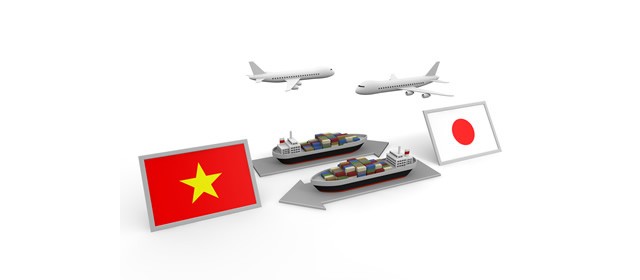
Making the most of benefits from FTAs: Vietnam-Japan trade 'takes off'
Latest
 |
| Japan is currently Vietnam's 4th largest trading partner, with bilateral trade turnover increasing steadily over the years. (Photo: smartlinklogistics) |
Potential Export Market
Vietnam and Japan officially established diplomatic relations on September 21, 1973. After more than 50 years of establishing diplomatic relations, economic and trade relations between the two countries have made significant progress, becoming a pillar of bilateral relations.
Japan is currently one of Vietnam's most important economic partners and the first country in the Group of Seven (G7) industrialized nations to recognize Vietnam's market economy status (October 2011).
Japan is also Vietnam's fourth-largest trading partner (after China, the United States, and Republic of Korea). Japan is the third-largest export market (after the United States and China) and the third-largest import market (after China and Republic of Korea) for Vietnam.
Statistics show that bilateral trade turnover between the two countries has steadily increased over the years. The total bilateral trade turnover in 2020 reached 40 billion USD; in 2021, it reached 42.7 billion USD; in 2022, it reached 47.6 billion USD; and in 2023, it reached 44.95 billion USD.
Therefore, the two countries have many opportunities to continue strengthening trade cooperation, especially in a world with many complex and unpredictable fluctuations.
Currently, Vietnam and Japan are members of four bilateral and multilateral free trade agreements (FTAs), including the Vietnam-Japan Economic Partnership Agreement (VJEPA), effective from October 1, 2009; the Regional Comprehensive Economic Partnership (RCEP), effective from January 1, 2022; the ASEAN-Japan Comprehensive Economic Partnership (AJCEP), effective from August 1, 2010; and the Comprehensive and Progressive Agreement for Trans-Pacific Partnership (CPTPP), effective from the end of 2018.
These FTAs have created an extremely important cooperation framework, contributing to the promotion of trade, investment, and business relations between the two countries on the principle of mutual benefit.
According to the Trade Promotion Agency of the Ministry of Industry and Trade, the bilateral and multilateral FTAs that Japan has signed with Vietnam have created extremely important cooperation frameworks, contributing to the promotion of trade, investment, and business relations between the two countries.
Japan has a highly developed economy, possesses world-leading advanced technology, and is one of the leading countries in the application of science and technology and the development of the digital economy and digital society. Meanwhile, Vietnam has an open economy with a high degree of openness, maintaining rapid development, and a young and abundant labour force.
In terms of the structure of goods, the two economies are highly complementary, not directly competitive, and have great potential for cooperation in areas such as technological innovation, digital transformation, and diversification of supply chains.
Vietnam mainly exports to Japan items including seafood, crude oil, textiles, electric wires and cables, wood and wood products, computers and components, coal, and various types of footwear. Meanwhile, Vietnam imports from Japan items serving industrial production such as machinery, equipment, tools and spare parts, electronic products and components, various types of steel, fabrics, raw plastics, chemicals, and raw materials for textiles and footwear.
Thus, many of the goods that Japan needs to import are those in which Vietnam has strengths and potential to become a main supplier for this Northeast Asian market.
Taking advantage of opportunities
Regarding trade exchanges between Vietnam and Japan in the near future, trade experts forecast that cooperation will be further supported as businesses from both sides leverage the advantages and tax incentives from FTAs such as the CPTPP and RCEP.
Moreover, Vietnam has been and continues to be an attractive destination for investment from Japanese businesses, thanks to the market's scale and growth potential.
 |
| Bac Giang's handicraft products are exported to Japan. (Source: Industry and Trade Newspaper) |
According to VGP, Mr. Nobuyuki Matsumoto, Chief Representative of the Japan External Trade Organization (JETRO) in Ho Chi Minh City said that thanks to bilateral and multilateral FTAs, goods from Vietnam to Japan generally enjoy competitive tax advantages. For instance, textiles benefit from a 0% tax rate when exported to Japan if they meet the rules of origin. For seafood products, Vietnam enjoys a 0% tax rate.
The JETRO Chief Representative in Ho Chi Minh City noted that since the bilateral and multilateral FTAs between the two countries came into effect, Japan has increasingly become an important export market for Vietnam, with continuous growth in export turnover and a more diverse range of export goods.
Conversely, according to a JETRO survey, due to Japanese companies operating in Vietnam relying on the import of components and raw materials, the utilization rate of VJEPA by Japanese businesses in Vietnam is as high as 52.1%.
According to him, Vietnam has become an attractive "magnet" in the eyes of investors by successfully signing and participating in new-generation FTAs, contributing to the expansion of import and export markets.
Mr. Nobuyuki Matsumoto noted that the current industrial structure has been shaped. Japanese companies in Vietnam are making the most of the opportunities provided by FTAs by importing raw materials and components from ASEAN markets or neighboring countries with existing FTAs to produce export goods in Vietnam. This presents an opportunity for Vietnamese businesses to accelerate and improve their competitiveness.
The JETRO Chief Representative in Ho Chi Minh recommended that to fully leverage the attractiveness of the Vietnamese market, businesses should be helped to understand the characteristics of each FTA, increase the utilization rate of incentives, and comply with procedural regulations (especially rules of origin and the value-added content ratio).
According to experts, Japan is a market with high demands on the quality and origin of products. However, stabilizing product quality is something that Vietnamese businesses are still weak at due to the small scale of production and processing.
When exporting to Japan, businesses should also note that inflation in Japan is very low, with an annual target of only about 2%. Therefore, Vietnamese exporters need to be careful not to raise prices too sharply, as this could reduce their competitiveness.
The 2022 survey report by JETRO shows that 60% of Japanese businesses in Vietnam plan to expand their operations within the next two years. Therefore, trade experts believe that the plans of many Japanese businesses to open new or additional manufacturing plants in Vietnam will be an important driving force for stronger trade exchanges between the two sides in the near future.




















